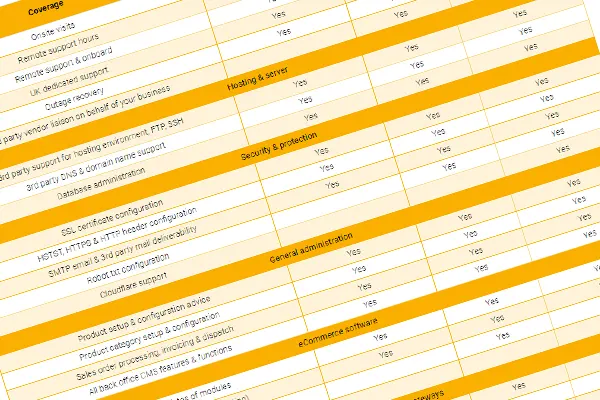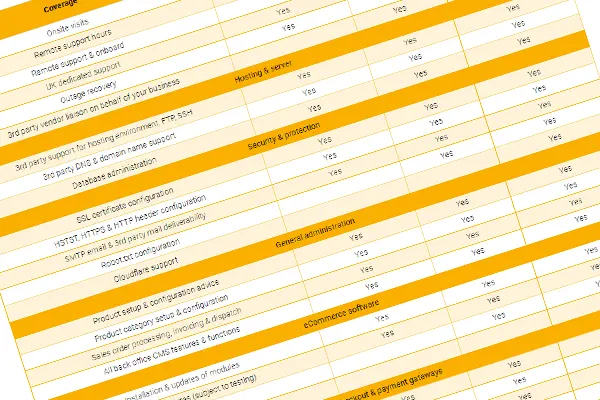Emma Taylor-Lane
16 December 2022
eCommerce
Emma Taylor-Lane
16 December 2022
Search Engine Optimisation, or SEO, is a key part in the success of any eCommerce business. It’s a powerful strategy that increases website visitors and traffic and, consequently, sales. But what is SEO and how does it help your eCommerce company? In this blog post we look at both of those questions and more.
eCommerce SEO is the process of making an online store, such as your personalisation business, more visible to search engines. That means getting your website up through the search engine rankings – preferably to the top of page one – using optimisation techniques to improve rankings and get your page in front of potential customers.
SEO is important to eCommerce because it increases the amount of organic search traffic sent to your online store. Organic traffic is the best type of traffic as it demonstrates trust in your brand and is one of the top factors for attracting new customers, as well as being lower cost than other forms of marketing.
SEO is an important way of increasing brand awareness. The higher your pages rank on search engine results (and we’re talking mainly Google here), the more you can improve the brand awareness of your business.
The higher your ranking in search engines, the more favoured your website is likely to be by people looking to buy the products you offer. Many people view high ranked websites for eCommerce stores as a powerful endorsement of the business, hence why rankings are so important.
While free organic traffic is great – obviously – targeted SEO traffic is likely to make the most difference for your business. That’s where optimisation comes in.
Optimisation is simply the art of using keywords to attract the interest of both search engines and those using them. Finding keywords requires analysis. What terms are your target audience searching for? Unless you do your research, you’re making a guess at how people think. And could easily be mistaking what you would search for with your industry knowledge compared to what lay people are looking for.
When people know what they’re looking for, it’s known as search intent. And your SEO needs to meet that search intent. That leads to targeted traffic from searchers who are seeking to buy what you’re supplying.
By focusing on strategic eCommerce SEO, you can identify and optimise the keywords that drive the most revenue to your business. However, identifying the correct terms is likely to take time, effort, and expertise. That’s why it’s often more cost-effective to employ a company or freelancer to do it for you.
Selling isn’t a single step process. Ranking your product pages is just one aspect of the sales ‘funnel’ – that is the process of moving from browser to confirmed sale. This is often known by the anacronym AIDA: attention, interest, desire, action.
SEO needs to work at each of these stages in the buying process, so content is important. Awareness is the ‘research’ part of the process. So strong, optimised and descriptive content is key.
Keywords may change as potential customers move through the purchasing funnel, and so this needs to be taken into account in your content, so that they can always find the information they’re looking for. Content needs to move from informational to transactional all within one page. If you can manage those queries – which again requires research – you increase the chances of a conversion.
Strong eCommerce SEO isn’t just about getting potential buyers to your website, it also guarantees a better user experience (UX). Their questions are answered, and their concerns allayed. And Google also appreciates this, helping you attract new business through higher rankings.
However, should visitors not find what they’re looking for and start clicking back to the results page, Google will see that as a poor experience and will drop you down the rankings. Can you afford for that to happen?
So, you’ve targeted your SEO traffic, optimised content for the complete sales funnel, and provided a great user experience for visitors. Together, this should lead to increased conversion rates for increased sales and, hopefully, profits. It’s that simple.
Great SEO means less need for paid search adverts. That means lower overall marketing costs. That money can be invested into other marketing channels, such as direct mail, or simply added to your profit margins.
With paid advertising, the vast majority of its impact ends when the money runs out and your campaign ends. But eCommerce SEO is the marketing that keeps on giving. Not just for days, but for months or even years in the future. It offers the longest ROI of any marketing channel, at the lowest cost. Is it a strategy you can afford to ignore?

So how do you do SEO for your eCommerce website? We’ll look at that now.
There’s no point blindly creating content for your eCommerce online store. You could be wasting a great deal of time and effort for no return. And it will take you some time to work out why you’re getting no results.
Instead, you need to do research, looking at three particular aspects:
Search intent might seem like an obscure term, but it just means what people are expecting to see when searching for a specific keyword.
Search intent can vary depending on the point in which the potential customer is in the sales funnel. We’ve already mentioned this, but your content needs to be relevant to each stage of the selling process. Again, keyword research is essential to ensure that you’re not missing out on business.
What does this mean? Well, most simply put, it means how your website is set up so that potential customers can easily find what they’re looking for. Ideally, it should be no more than three clicks from homepage to product. The more clicks to find the product, the less likely you are to make a sale.
How can you do this? Category pages should be linked to from the homepage alongside a few of your best-selling product pages. Google tends to rank the homepage as the highest authority page on your website and direct links to these pages increases the change of those pages also ranking higher.
Yes, it may not have your products on it, but your homepage is critical for attracting visitors to your site. Therefore, it should be optimised for what are known as ‘short-tail keywords’; that is, those that are just one to two words in length. For example, a workwear homepage should include terms such as ‘uniforms and ‘PPE’.
Long-tail keywords, such as ‘best safety shoes for builders’ should be restricted to product review or blog pages.
Not only does the homepage content need to be optimised, but you also need to look at meta titles and descriptions, and H1 and H2 tags for the short-tail keywords to keep Google happy. If you’re unsure how to do this, or even what the terms mean, it’s best to consult an expert.
Category pages also need to be optimised for SEO. These are your ‘top-level’ pages for your products, for example, ‘workwear’ which may have ‘trousers’ and ‘hi-viz vests’ underneath it. These must provide content that is relevant to the linked product pages. Again, short-tail keywords should be used.
As well as targeting keywords in the content, meta titles and descriptions and headings, they should also be included in the URL (page address) and any images included.
Arguably the most important pages for SEO on an eCommerce website because these are the pages that most people are searching for. On these pages, you should be using short- to medium-tail keywords, and including them in image filenames, title attributes and metadata as well as all the usual places. Content should be at least 1,000 words long to improve the relevance of the page and include target keywords as exact matches.
There are three reasons for internal links on an eCommerce site. These are:
There are good strategies to follow for internal linking that will boost you up the Google rankings:
One way of increasing your internal linking is to have a blog on your website. Linking to related products in your blog posts will improve eCommerce SEO and add to the appeal of your site to keep visitors there longer.
Linked (sorry!) to the above is link-building. This is the process of getting high-quality and relevant websites to link to your website and increase its authority. Quality links have high domain authority and connecting with these pushes your website up the search engine rankings.
There are three common ways of achieving this:
The faster your page loads, the happier Google is. Research shows that over half of all users will click away from your site if it takes more than three seconds to load. That’s a lot of lost potential custom if your site is slow.
Mobile-first indexing is a fancy way of saying that Google mainly uses the mobile version of a website to index and rank your site. That means that your site must work well on mobile devices as well as on laptops and tablets. Any reputable website developer will ensure that your site works across all types of devices for the best user experience.

We’ve covered what eCommerce SEO is, why it’s important, and how to implement it. While you can do it yourself for your eCommerce personalisation business, it’s a time-consuming process that requires knowledge and understanding of how SEO works. That’s why it’s always best to employ an experienced organisation to undertake these processes for you.
At Demystify Digital, we not only build eCommerce websites along with back-office systems and ERP software, but ensure that they are properly optimised for the best possible rankings.
If you want to discuss your eCommerce website and find out more about whether it’s properly optimised for SEO, Demystify Digital offers a FREE one-hour consultation. Get in touch today on 01903 372 402 or email [email protected].
Think or can help or need to talk? Book an online Teams meeting today or call 01903 372 402
Contact us details can be found below. If you fancy a chat, please feel free to call.
Demystify Digital Limited is a limited company registered in England and Wales. Registered number: 13844077.
© 2022 Demystify Digital Limited. All rights reserved
| Cookie | Duration | Description |
|---|---|---|
| cookielawinfo-checkbox-analytics | 11 months | This cookie is set by GDPR Cookie Consent plugin. The cookie is used to store the user consent for the cookies in the category "Analytics". |
| cookielawinfo-checkbox-functional | 11 months | The cookie is set by GDPR cookie consent to record the user consent for the cookies in the category "Functional". |
| cookielawinfo-checkbox-necessary | 11 months | This cookie is set by GDPR Cookie Consent plugin. The cookies is used to store the user consent for the cookies in the category "Necessary". |
| cookielawinfo-checkbox-others | 11 months | This cookie is set by GDPR Cookie Consent plugin. The cookie is used to store the user consent for the cookies in the category "Other. |
| cookielawinfo-checkbox-performance | 11 months | This cookie is set by GDPR Cookie Consent plugin. The cookie is used to store the user consent for the cookies in the category "Performance". |
| viewed_cookie_policy | 11 months | The cookie is set by the GDPR Cookie Consent plugin and is used to store whether or not user has consented to the use of cookies. It does not store any personal data. |